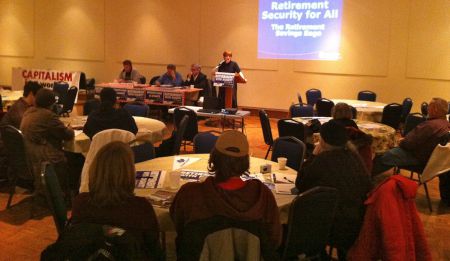On March 2, a community assembly was held to strategize on methods to pressure the federal government to expand Canada Pension Plan (CPP) benefits.
“The CPP is one of the great accomplishments of public policy in this country,” said John Hugh Edwards, National Representative of Canadian Labour Congress' (CLC) Social and Economic Policy Department. “It has just one serious flaw: there isn't enough money in it. The maximum amount a person can get through the CPP when they retire is about $900/month. But the average amount that most retirees draw from it at present is closer to $500/month”. Currently the CPP only pays out about 25% of the average national wage.
About 60 people, including labour unionists, anti-poverty activists, seniors, community leaders, and several students, gathered at the Italian Cultural Centre in Halifax for the two-hour assembly organized by the CLC, Nova Scotia Federation of Labour (NSFL) and Halifax-Dartmouth and District Labour Council (HDDLC). It was one of many assemblies being organized across the country over the campaign to improve the Canada Pension Plan.
The impetus for the event was the recent about-face of the Harper Conservatives, who have decided not support an expansion of the CPP. As early as November 2010, the federal Conservatives were supportive, but in December plans to expand the CPP were scrapped and a proposal to create PRPPs, or Pooled Registered Pension Plans, was put forward.
The Federal Government's abandonment of plans to strengthen and expand the CPP comes despite the fact that the proposal has broad public support: a January 2011 poll showed that approximately 76% of Canadians are supportive of increasing CPP benefits. In all, seven provinces have officially expressed support and the Federation of Canadian Municipalities and Federation of Canadian Students are among other groups that have endorsed the plan.
“We have a request in for access to information to see who was lobbying the government in these last few months, to determine why the Conservatives changed their minds” said Barb Byers, CLC Executive Vice-President.
A 'Tommy Douglas Moment' for Pensions
“As the Finance Minister of PEI recently stated,” said Edwards, “it is a 'Tommy Douglas moment' for pensions in this country right now”. Edwards agreed with the Minister who compared the current situation of trying to improve public pensions with that of trying to improve national health care coverage in the 1960s - while the plan has broad support amongst the provinces and the general public, there are a minority of business interests who have come out against it: the Canadian Federation of Independent Business (CFIB), the CD Howe Institute are a few.
Currently, workers pay 4.95% of their annual wages to the CPP. Their employer then matches this amount. The plan of the CLC would see an increase of employee and employer payments to 7.7% of annual income, phased in over a 7 year period, to double the average per-person CPP payout upon retirement.
The CPP vs. PRPPs
There are several key differences between the CPP and the PRPPs. One of the most important aspects of the CPP is that it is a defined benefit program, meaning there is a guaranteed amount of funds a person will receive upon retirement with a high predictability of benefits. For the employer and employee, payment into the CPP is mandatory, and cost sharing of payments between employees and employers is a 50:50 split. The program is “portable”, meaning it moves with the worker despite any change in employment, and has relatively low overhead management costs.
PRPPs are defined contribution plans only and do not have a defined benefit amount when people retire. The retirement benefits a person may obtain are open to fluctuations to investments and market changes, and notably, employers also have the ability to opt out of payment into the program.
“It is absolutely critical to keep pressure on our public representatives on the issue of CPP expansion” said Byers. “We are in a situation where 1.6 million seniors are trying to live on less than $15,000 a year”.
Edwards stated that like in the US, while income for the highest earners in Canada have gone up over the last 30 years, wage growth for the rest has mostly stagnated, and for the lowest income groups actually declined. He noted that savings for the average worker have thus predictably been declining since the 1980s. “In 1982, average worker savings were in the range of 20% of income. Now it is closer to 5%,” said Edwards.
Student and Youth Concerns
The panel noted a high number of youth and students at the assembly compared to other recent meetings. Kaley Kennedy, a recent graduate, spoke of her support for expanding the CPP.
“I am a university graduate and want to say that I will never be able to retire on something like what is proposed for the PRPP,” Kennedy said. “Many people my age are out of school now with thousands of dollars in student loan debt. We are starting behind, and it is very difficult for us to make any personal savings. I think we should be looking at the pension issue the same way we look at health care in the country: as a social right”.
Before group discussion began, Rick Clarke, NSFL President, voiced the NSFL's support for increasing CPP benefits, despite the recent rejection of the plan by the federal government. “We've seen Harpers come and go, but the people stand.” said Clarke. “We can make it happen. Now let's get at it.”
Facts on Pensions in Canada
- 93% of the workforce in Canada pay into the CPP
- Other than the CPP, 60% of the Canadian workforce have no pension plan
- The ability to make RRSP investments for retirement varies widely around income levels; In 2006, almost 70% of Canadians made no RRSP contributions.
- Less than 40% of the workforce have private pension plans
- An estimated 1/3 of Canadians aged 24 and older have no personal savings






